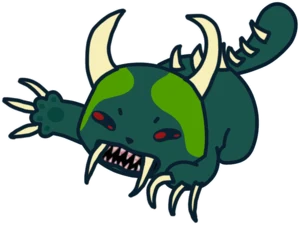Fearsome Critters are cryptids that are unique to North American lumberjack folklore that date back to the 20th century. Much like how housewives would tell their children not to walk underneath a ladder least ye' be cursed with bad luck, tall tells of the critters were used to haze newcomers who had come to the frontier for work. An example being the Dungavenhooter that hunts for lumberjacks that drink on the job, "Rum-sodden prey is sought with especial eagerness."  Having said that, the critters were more often than not described as comical looking.
Having said that, the critters were more often than not described as comical looking.
Some of the critters are pretty well known, such as Bigfoot and the Jackalope, but most tales of the critters only survive by newspaper clippings and the books written about them, such as:
Which is what we'll be taking a look at today. For further reading you can check out the America's Fearsome Creatures by Aoty, The Fearsome Critter Database by the Lumberwoods Unnatural History Musume., The Fearsome Critter page at the Cryptid Wiki and the Book Of Creatures Blog.
THE GUMBEROO
(Megalogaster repercussus.)
In the foggy region along the Pacific Coast from Grays Harbor to Humboldt Bay there ranges a kind of creature that has caused much annoyance in the lumber woods. This is the gumberoo, which, luckily, is so rare that only once in a great while is one seen. It is believed to remain in hiding most of the time in the base of enormous, burned-out cedar trees, from where it sallies forth occasionally on frightful marauding expeditions. During these periods of activity the beast is always hungry and devours anything it can find that looks like food. A whole horse may be eaten at one sitting, distending the gumberoo out of all proportions, but failing to appease its hunger or cause it the slightest discomfort.
The specimens seen are reported to have been coal black, but that may have been due to their being smirched with the charred wood. In size the beast corresponds closely to a black bear, for which it might be mistaken only for the fact that the gumberoo is almost hairless. To be sure, it has prominent eyebrows and some long, bristly hairs on its chin, but the body is smooth, tough, and shiny and bears not even a wrinkle. The animal is a tireless traveler when looking for food, but is not swift in its movements or annoyed in the slightest degree by the presence of enemies. The latter characteristic is easily accounted for by the fact that no other animal within its range has ever found a successful method of attacking a gumberoo or a vulnerable spot in one's anatomy. Whatever strikes the beast bounds off with the same force. Its elastic hide hurls back with equal ease the charging elk and the wrathy hornet. A rock or peavey thrown at the creature bounds back at whoever threw it, and a bullet shot against its hide is sure to strike the hunter between the eyes.
It is believed that the scarcity of gumberoos is due to their combustible character and the prevalence of forest fires. The animal burns like celluloid, with explosive force. Frequently during and after a forest fire in the heavy cedar near Coos Bay woodmen have insisted that they heard loud reports quite unlike the sound of falling trees, and detected the smell of burning rubber in the air.
THE SNOLIGOSTER
(Dorsohastatus caudirotula.)
In the cypress swamps of the South, and particularly in the region about Lake Okechobee, Florida, woodmen tell of a strange and dangerous animal known as the snoligoster. This creature is of enormous proportions and is credited with a voracious appetite. Worst of all, its appetite is only appeased by the eating of human beings. In form the snoligoster resembles a huge crocodile, but it is covered with long, glossy fur and has no legs or fins, except one long spike on its back. A person naturally wonders how such an animal can manage to travel through the water and mud of the swamp region where it lives, but nature has provided it with a means for driving itself along. On the end of its tail are three bony plates much resembling the propeller on a steamboat. These revolve at a terrific rate, driving the animal like a torpedo boat through mud. They serve other purposes as well, for when a snoligoster catches an unfortunate pickaninny, or even a fullgrown negro, upon which it delights to feed, it tosses the victim up and backward so as to impale him upon the spike fin, where several may be carried until sufficient for a meal have been collected. The snoligoster's tail is then driven into the mud and revolved until a hole is scooped out and the victims scraped off the spike and tossed in, whereupon the snoligoster beats them into batter with its rapidly revolving propeller and inhales them.
Mr. Inman F. Eldredge, of De Funiak Springs, Flordia, while hunting for an outlaw negro in the swamps, had a most unusual experience. He caught sight of the negro, dead and impaled upon what at first appeared to be a slender cypress knee, but which presently began to move away. It was then seen to be the spike on a snoligoster's back. Eldredge's first impulse was to shoot the strange beast, but upon second thought he concluded that it was doing a good work and was entitled to live on. The very report of such a creature inhabiting the swamps would deter evil-doers from venturing into these wild places to avoid their pursuers and escape justice.
THE LEPROCAUN
(Simiidiabolus hibernicus horribillis.)
During the early days of Upper Canada, before it became the Providence of Ontario, there were brought into a logging camp on the Madawaska River several young leprocauns from the north of Ireland. This animal was even then rare and has since become extinct in its native land. It is said that during the last famine hungry Irishmen killed and ate the few remaining specimens of this queer beast.
On its native bogs the leprocaun was a harmless creature, celebrated for its playfulness and laughable antics. It would hop across the bogs, turn somersaults, and leap over hillocks with wondrous agility. A favorite trick was to bore into a pile of drying peat and then, with a sudden spring, send the clods of peat high in the air till the commotion looked like a young cyclone. These antics were all right enough in Ireland, but when the animal was brought to Canada its disposition changed at once. The pets on the Madawaska escape into nearby tamarack swamps, increasing and spreading until an occasional one was seen on the upper Ottawa and even over in northern Michigan. Sneaking through the tamarack and cedar , or leaping across the muskegs after whatever appealed to it as food, the leprocaun became a creature to be feared and avoided. Teamsters toting supplies across swamp roads have been attacked by the animal, which would bound clear over the load, snapping its teeth at the driver and reaching for him with its villainous claws. Hasty flight to thick timber, leaving the team to its fate, was the only choice of the driver, who thanked his stars that in running through tangled tamarack even the leprocaun is no match for a frightened man.
THE SLIDE-ROCK BOLTER
(Macrostoma saxiperrumptus.)
In the mountains of Colorado, where in summer the woods are becoming infested with tourists, much uneasiness has been caused by the presence of the slide-rock bolter. This frightful animal lives only in the steepest mountain country where the slopes are greater than 45 degrees. It has an immense head, with small eyes, and a mouth somewhat on the order of a sculpin, running back beyond its ears. The tail consist of a divided flipper, with enormous grab-hooks, which it fastens over the crest of the mountain or ridge, often remaining there motionless for days at a time, watching the gulch for tourists or any other hapless creature that may enter it. At the right moment, after sighting a tourist, it will lift its tail, thus loosening its hold on the mountain, and with its small eyes riveted on the poor unfortunate, and drooling thin skid grease from the corners of its mouth, which greatly accelerates its speed, the bolter comes down like a toboggan, scooping in its victim as it goes, its own impetus carrying it up the next slope, where it again slaps its tail over the ridge and waits. Whole parties of tourists are reported to have been gulped at one scoop by taking parties far back into the hills. The animals is a menace not only to tourist but to the woods as well. Many a draw through spruce-covered slopes has been laid low, the trees being knocked out by the roots or mowed off as by a scythe where the bolter has crashed down through from the peaks above.
A forest ranger, whose district includes the rough county between Ophir Peaks and the Lizzard Head, conceived the bold idea of decoying a slide-rock bolter to its own destruction. A dummy tourist was rigged up with plaid Norfolk jacket, knee breeches, and a guide book to Colorado. It was then filled full of giant powder and fulminate caps and posted in a conspicuous place, where, sure enough, the next day it attracted the attention of a bolter which had been hanging for days on the slope of Lizzard Head. The resulting explosion flattened half the buildings in Rico, which were never rebuilt, and the surrounding hills fattened flocks of buzzards the rest of the summer.
This one's my favorite critter. 
THE WHIRLING WHIMPUS
(Turbinoccissus nebuloides.)
Occasionally it happens that inexperienced hunters and others wandering in the woods disappear completely. Guides are unable to locate them, and all kinds of theories are offered to explain the disappearances.
From the hardwood forests of the Cumberland Mountains, Tennessee, comes the rumor of an animal called the whirling whimpus, the existence of which may throw some light upon the fate of those who fail to come back to camp. According to woodsmen who have been “looking” timber in eastern Tennessee, the whimpus is a blood-thirsty creature of no mean proportions. It has a gorilla-shaped head and body and enormous front feet. Its unique method of obtaining food is to station itself upon a trail, generally at a bend in the trail, where it stands on its diminutive hind legs and whirls. The speed is increased until the animal is invisible, and the motion produces a strange droning sound, seeming to come from trees overhead. Any creature coming along the trail and not recognizing the sound is almost certain to walk into the danger zone and become instantly deposited in the form of syrup or varnish upon the huge paws of the whimpus.
THE AGROPELTER
(Anthrocephalus craniofractens.)
Leading a vengeful existence, resenting the intrusion of the logger, the agropelter deals misery to the lumber jack from Maine to Oregon. Ill fares the man who attempts to pass a hollow tree in which one of these creatures has taken up its temporary abode. The unfortunate is usually found smashed or pinned by a dead branch and reported as having been killed by a falling limb. So unerring is the aim of the argropelter that despite diligent search I have been unable to locate more than one man who has been the target for one of their missiles and yet survived to describe the beast. This is Big Ole Kittleson, who, upon a certain occasion, when cruising timber on the upper St. Croix, was knocked down by a partly rotten limb thrown by an argropelter. This limb was so punky that it shattered on Ole's head, and he had time to observe the rascally beast before it bounded from the tree and whisked itself off through the woods.
According to Ole, the animal has a slender, wiry body, the villainous face of an ape, and arms like muscular whiplashes, with which it can snap off dead branches and hurl them through the air like shells from a six-inch gun. It is supposed to feed upon hoot owls and woodpeckers, the scarcity of which will always prevent the argropelter from becoming numerous in any locality
THE SPLINTER CAT
(Felynx arbordiffisus.)
A widely distributed and frightfully destructive animal is the splinter cat. It is found from the Great Lakes to the Gulf, and eastward to the Atlantic Ocean, but in the Rocky Mountains has been reported from only a few localities. Apparently the splinter cat inhabits that part of the country in which wild bees and raccoons abound. These are its natural food, and the animal puts in every dark and stormy night shattering trees in search of coons or honey. It doesn't use any judgement in selecting coon trees or bee trees, but just smashes one tree after another until a hollow one containing food is found. The method used by this animal in its destructive work is simple but effective. It climbs one tree, and from the uppermost branches bounds down and across toward the tree it wishes to destroy. Striking squarely with its hard face, the splinter cat passes right on, leaving the tree broken and shattered as though struck by lightning or snapped off by the wind. Appalling destruction has been wrought by this animal in the Gulf States, where its work in the shape of a wrecked forest is often ascribed to windstorms.
THE CENTRAL AMERICAN WHINTOSSER
(Cephalovertens semperambulatus.)
In the spring of 1906 there appeared suddenly in the Coast Ranges of California an uncanny animal from the region of the Isthmus. It is not a large beast, but what it lacks in size it makes up in meanness of disposition. None of the lumber jacks who have met a whintosser on trail or tote road care to have the experience repeated. The Central American whintosser is always looking for trouble or making it. In fact the beast seems to be constructed for the purpose of passing through unusual experiences. Its head is fastened to its body by a swivel neck ; so is its short, tampering tail ; and both can be spun around at the rate of a hundred revolutions a minute. The body is long and triangular, with three complete sets of legs ; this is a great convenience in an earthquake country, since the animal is not disturbed by any convulsions of the earth. If the floor suddenly becomes the ceiling it does not matter, for the whintosser is always there with the legs. Its hair is bristly, and all slants forward at a sharp angle. It has been found that a cat's nine lives are as nothing to the one possessed by a whintosser. This animal may be shot, clubbed, or strung on a pike pole without stopping the wriggling, whirling motions or the screams of rage. The only successful way of killing the beast is to poke it into a flume pipe so that all its feet strike the surface, when it Immediately starts to walk in three different directions at once and tears itself apart. John Gray, of Anadar, Trinity County, California, knows where a pair of whintossers live in some broken-up country along Mad River.
THE TRIPODERO
(Collapsofemuris geocatapeltes.)
The chaparral and foothill forests of California contain many queer freaks of one kind and another. One of the strangest and least known is the tripodero, and animal with two contractile or telescopic legs and a tail like a kangaroo's. This peculiarity in structure enables the animal to elevate itself at will, so that it may tower above the chaparral, or, if it chooses, to pull in its legs and present a compact form for crowding through the brush. The tripodero's body is not large but is solidly built, and its head is nearly all snout, the value of which is seen in the method by which food is obtain. As the animal travels through the brush-covered country it elongates its legs from time to time, thus shoving itself up above the brush for purposes of observation. If it sights game within a range of ten rods it takes aim with its snout and tilts itself until the right elevation is obtained, then with astonishing force blows a sundried quid of clay, knocking its victim senseless. (A supply of these quids is always carried in the left jaw.) The tripodero then contracts its legs and bores its way through the brush to its victim, where it stays until the last bone is cracked and eaten.
THE COME-AT-A-BODY
(Quadrupes inprovisus)
Reported by Mr. B.B. Bickford of Gorham, N.H. Not found outside the White Mountains. A short, stubby, rather small animal resembling a Woodchuck but having very soft, velvety, kitten-like, fur. Harmless, but surprising. Has the terrifying habit of suddenly rushing directly at you from the brush, then stopping only a few inches away and spitting like a cat. A strong mink-like scent is thrown and the Come-at-a-Body rushes away.
THE DUNGAVENHOOTER*
(Crocodilus hauriens)
Formerly quite common from Maine to Michigan. Today only occasionally met with on the Upper Peninsula of the latter state.
A marsh-dweller, dangerous to human beings. Shaped a good deal like an alligator, but curious as to equipment in that he has no mouth. The nostrils are abnormally large, the legs short and the tail thick and powerful. The only cry is a loud snort.
Concealing itself with Satanic cunning behind a whiffle bush, the Dungavenhooter awaits the passing logger. On coming within reach of the dreadful tail, the victim is knocked senseless and then pounded steadily until he becomes entirely gaseous, whereat he is greedily inhaled through the wide nostrils.
Rum-sodden prey is sought with especial eagerness.
*Not to be confused with the New Brunswicker ghost legend, the “Dungarvon Whooper.
THE HIDEBEHIND
(Ursus dissimulans)
A highly dangerous animal, but, owing to its intense aversion to the odor of alcohol, never known to attack an inebriate. One bottle of Uno beer has been proven to be a complete safeguard even in thickly infested country.
A biggish beast, standing about six feet and walking erect. The slender body makes it possible to hide completely behind the bole of a ten inch tree. The pelt is long thick, and black, and the tail is carried recurved. Looks like a French sheepdog's. Almost impossible to tell whether the critter is going or coming, and practically hopeless to locate its face—if any. The short, well-muscled forelegs are equipped with grizzly-like claws.
Its food is chiefly intestines. Leaping from its hiding-place with a demoniacal laugh, it swiftly disembowels its victim with one swipe. Sometimes the fiendish howl frightens the prey to death before the blow falls.
The Hidebehind is never found in the open. He always conceals himself behind a tree trunk. His marvelously quick, stealthy gait makes it possible for him to stay constantly behind his prey, no matter how quickly the suspicious victim may spin about in the hope of glimpsing the marauder. The beast can go seven years without eating.
I like that with the Dungavenhooter we learn to not drink on the job, but with the HIdebehind we need to be wasted to safely travel the wooded trail. 
THE HODAG
(Deformis corniger lacrimans)
Reported in Maine many years past, and in 1895 captured and positively identified near Rhinelander, Wisconsin, by Mr. E. S. Shepard, the Hodag is indubitably one of the best-known of the larger and more dangerous woods varmints. It is now very rare, probably owing to the increased use of lemons in cookery, for Hodags and citrus fruits are in the same ratio as wolves and wolfbane—probably more so.
A distressingly ugly animal. The knobbledy head wears a pair of prominent, bulging eyes and two heavy lateral horns something after the fashion of a male stag-beetle. The claws are stout and powerful, the tail carries a terminal hook, while a row of jagged, stegosaurian dorsal spines complete the picture. The smaller front teeth were formerly often used for umbrella handles.
The Hodag is fully aware of his upsetting appearance, and is given to frequent fits of bitter weeping. I once had a handful of the extremely rare crystallized Hodag tears, but an acquisitive lady friend collected them, believing them to be fine amber. She had them strung into a neck-yoke—and then went and spilled a Tom Collins on herself. Of course the lemon juice dissolved them instantly.
This fellow can't endure being laughed at. When angry, he is fierce and dangerously aggressive. But a pair of lemons is ample protection against a whole herd.
Reminds you of someone, don't it? 
THE HOOP SNAKE
(Serpenscirculousus caudavenenifer)
A well-known menace. Its existence is thoroughly established by numerous reports from highly creditable parties. The characteristics appear to be about the same in all regions. Its habit of tucking its tail in its mouth and rolling at incredible speed in pursuit of its prey, or a fancied enemy, is not duplicated fortunately, by any other member of the animal kingdom.
The tail ends in a stinger carrying venom of such power that a dose of but 0.003 p.p.m.* is sufficient to make even the leather-skinned Hodag turn green and swell up and die inside of an hour. No wonder that folks wise in woods lore are wary of this circular engine of destruction. He may travel on just one cylinder but that's all he needs.
The speed reached in rolling is nothing short of remarkable. A full grown jack-rabbit is pie for this Snake. A mature Snake, when hooped, has a diameter of 1.5923 feet. He has been clocked, after being enticed on to a cleverly designed rolling metered platform at an r.p.m. of about 1056, or a straightaway speed of some 60 m.p.h. The only way to outrun him is to climb over a fence. The Snake must unhoop to get through.
There are many authentic cases of death from this reptile's venom; possibly the most convincing bit of data is that, in a fit of pique, a Hoop Snake stung one of Paul Bunyan's peavy handles. Of course this handle was a sizeable stick to start with, but the venom swelled it to such dimensions that Paul cut it up into 946 cords of wood. And then the dang stuff wouldn't burn. Just lay in the stove and hissed.
*: Parts per million.
THE LUFERLANG
(Spinacaerulea tresarticulosus)
A dangerous fellow to meet up with. Very likely to attack without any provocation. Bites but once a year, but the bite is sure death.
Certain unique features make it easy, however, to identify the animal. A dark blue stripe down the spine, a bushy, swivel-jointed tail set in the middle of the back (this appendage is most useful in keeping off the flies) and all four legs triple-jointed are what the traveler should look for. These legs make it possible for the Luferlang to run equally fast in all directions. In case of an attack, the victim should suddenly hold a large mirror up beside himself. The double image will so confuse the beast that he will rush off in disgust.
The biting season usually occurs on July 12. An orange-colored handkerchief conspicuously displayed will invariably afford full protection. Green clothing of any shade should be studiously avoided at this season, as it serves to arouse the animal further.
Wait a minute...

THE TREE-SQUEAK
(Arborexusta stridens)
Some folks will claim that the mating call of the Treesqueak is just a dry tree lodged in a “school marm.“ But we old boys know better. The sound is made by an untrustworthy animal still quite common in the North Woods. Built something like a weasel, and with the same nice, friendly disposition he is chameleon-like, and can wrap himself around a tree-trunk and match the bark exactly.
He is sometimes aggressive, but only after a long, dry spell. Has a variety of calls; a whine like a panther, a squeal like a young pig, and sometimes a roar like a bunch of cannon crackers at a shotgun wedding. Look out for him on windy days along towards sundown.
THE WHIFFENPOOF
(Sometimes called the Gilli-Galoo Fish)
(Piscisabsurdus tumescens)
A tasty fish, found only in perfectly round lakes. Hence quite rare. To catch him, row to the exact center of the lake, using the hogyoke to determine position, and bore a square hole in the water. Bait the edge of this hole with a bit of cheese, preferably Brie, Stilton, Liederkranz, or best of all; Limburger. The Whiffenpoof will quickly scent the bait and come for it. When he emerges, spit tobacco-juice in his eye. This will make him so swell with rage that he won't be able to withdraw into the hole, and you can easily net him.
THE SNIPE
(Scolopax inexplicabilis)
A common bird, occasionally seen, but never yet caught. Legions of sharp-eyed young foresters, engineers, cruisers, cookees, rodmen and hard-rock apprentices have made repeated, careful, and valiant attempts to corral one, but notwithstanding the bushels of careful advice and instruction handed out by the older hands in the party, success has not yet been attained. Seldom does the seasoned woodsman make the attempt; he is probably too discouraged to try again. > But he is often willing to travel along with the hunting party just to see what happens, or perhaps to offer an occasional word of advice.
Many years ago I was taken on a snipe hunt and was able to get a good look at one bird which strayed near the bag I was so carefully holding. I couldn't get my hands on the little fellow, but I did have time to study him a bit, and I find that my observations tally very closely with a detailed report received from Mr. > Howard S. Gardner. Here's the summary.
A bird of marvelous coloration: green, blues, pinks, and here and there the glint of gold. Wears both fur and feathers, with the fur side inside, like Mudjekeewis.* Stands erect, about 17 cm high on two legs, but has a third auxiliary slightly aft, for use either as a stabilizer or as a starting mechanism. Lacking this additional leg, permanent unstable equilibrium would result. The eyes are fired with a constant, sulphurous glow, occasionally emitting small showers of sparks. One pupil is vertical, one horizontal, and winking is done alternately, keeping the Snipe constantly alert. His sharply hooked little beak is mounted on a bull-wheel base like a steam shovel, making possible the capture of insects without turning the head.
All in all, a most interesting and elusive animal. The fur-and-feathers combination makes the ideal protective coat for the natural marshy habitat. When the Snipe is swimming, the ridged feathers fold back, forming a perfectly smooth outer surface which reduces skin friction to a minimum. With the fur inside, the Snipe possesses a waterproof, fur-lined overcoat.
*: Figure of Ojibwe legends.
THE DUCK-FOOTED DUM-DUM
(Ventertympanum coxi)
“Not much fish in the lake this summer,” said the old guide sadly, as he rowed with his party across the sun-flecked water where the glistening fish were supposed to be waiting hungrilly for some one to offer them bait.
“What's the matter?” asked the “chap from the city,” on his first trip into the Big Woods.
“Those know-it-all game wardens scared the duck-footed dum-dum away, that's what. Ever see a dum-dum? Funny animal. Comes around every spring. He has two tails like bass-drum sticks and swings them like lightning, beating on the tight drum-like skin on his back.”
“Well, when the fish hear this they all flock near the shore in shallow water and lay their eggs. They wouldn't know it was spawning season if they didn't hear the dum-dum. Then after they lay their eggs they go away and the dum-dum keeps watch until all the little fish are hatched out.”
“So you see when those pesky game wardens come spying around and scare off the dum-dum, we don't get any fish.” And the guide pulled glumly at his little black pipe.
This lil' guy is actually from the Yarns of the Big Woods book but I just had to include him.
Well folks that's it for now, but again I stress that this was just some of the critters. If you want to read more about these weird monsters than be sure to check out the links provided above.


































 Links
Links 
Jump in the discussion.
No email address required.
Why didn't you ping me? You're supposed to ping me on all fearsome critters posts. That's one of the rules.
Jump in the discussion.
No email address required.
I'm sorry babe I didn't know. I'll make a note for next time.
Jump in the discussion.
No email address required.
More options
Context
More options
Context